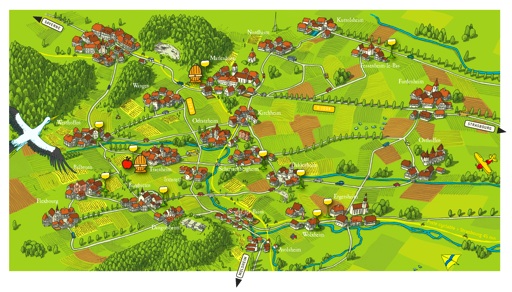
The Golden Circle around Strasbourg - La Couronne d'Or
Association La Couronne d'Or
In 1994 the association La Couronne d'Or, The Golden Circle, was formed. Within La Couronne d'Or as many as 21 villages, 15 wine producers, two cooperatives and one fruit merchant cooperate to strengthen and to market the area west of Strasbourg.
The map below (used with kind permission of La Couronne d'Or) illustrates the geography. The distance between the individual villages is rather small, typically 2 km. Hence, the La Couronne d'Or forms a circle some 20 km in diameter.

Click on image to view full resolution map (2,4 MB).
Background
As early as in 589 A.D., the Bishop of Tours praised the Merovingian vineyards west of Strasbourg. The area in question is the one delimited by Nordheim in the north, Westoffen in the west, Ostheim in the east and what is now Molsheim in the south. Already in those days, the area was of great economic as well as strategic importance.
Besides the small wine-growing area around Wissembourg close to the German border in the very north of Bas-Rhin, the busy town of Marlenheim serves s the northern gate to vineyards of Alsace. Indeed, this is also the starting point of the Alsace wine road, Route des Vins d'Alsace, which dwindles some 150 km until it reaches the southern entrance in Thann.
Despite the proximity to the metropolitan area of Strasbourg, only 20 km away, the area between Marlenheim and Molsheim is sadly overlooked by foreign visitors. This is particularly astonishing considering that the area comprises four exciting Grand Crus and 1 400 hectares of vineyards, i.e. 10% of the viticultural area of Alsace. Benefitting from 'immigration' from Strasbourg, the 20+ villages in the area are vital and lively, but do also show genuine Alsatian charm with narrow alleys lined with half-timbered houses, lovely courtyards, all drenched in flowers.
For long, the farmers in the area had wine-growing as one of many crops. Still, cultivation of fruits, vegetables and cereals are important, not to mention grazing cattle. Considering the vast area, relatively few producers market wines under their own label, instead two large cooperatives have been dominating. With this background, it is not surprising that the visibility of the wines and vineyards visa-vi the public has been relatively low.